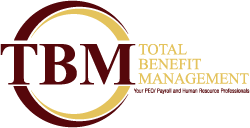- Total Benefit Management

Impact of Human Resources On Organizational Performance: Why Great HR Matters
October 3, 2022
What is Employee Leasing and How Can It Help Your Business?
October 10, 2022Employee performance determines the success of your business.
Running a team is a give-and-take arrangement. Employees perform their best within workplaces that support continuous growth and offer competitive compensation.
Guidelines for Boosting Employee Performance
Is your organization’s leadership team interested in improving employee performance? Let’s review actionable, effective personnel management strategies that support a thriving and motivated staff.
Define What “Performance” Means to Your Business
“Performance” can be defined in many ways. An employee’s performance is measured differently depending on their role, the industry they work in, and the leadership style of their managers.
Sometimes, employee performance is characterized by specific numeric benchmarks, such as producing or selling a certain number of product units. In other cases, performance may be defined more qualitatively, such as how well an employee exhibits certain attitudes or behaviors.
Either way, what’s important is that performance is defined thoughtfully and deliberately and that employees know what sort of performance they should be striving for.
Develop Performance Metrics
Determine the actions or metrics that are most important for measuring your employees’ performance.
Performance metrics may include:
- Work quantity metrics
- Work quality metrics
- Evaluation reports from supervisors
Work quantity metrics involve objective productivity measurements, such as the number of times an employee completed a certain task.
Work quality metrics involve how well duties are performed. Work quality may be measured by data points such as the number of errors committed, or may be evaluated more holistically by reviewing the employee’s body of work.
Evaluation reports from supervisors are also useful. Such reports can take an employee’s overall performance and summarize it in a numeric score. However, this sort of evaluation should be used carefully. Different supervisors may have different evaluation styles, which could create “apples to oranges” score comparisons across the staff.
Be Transparent About Performance Requirements
If you want your staff to hit certain targets, then they should know what those targets are. When your employees have a clear understanding of what’s expected of them, they’re better able to set and work towards goals.
If your company has a clear definition of performance and evaluates staff with useful performance metrics, then that information should be disseminated throughout the company. Employee handbooks, one-on-one check-in meetings, and performance reviews all provide opportunities to discuss performance requirements with your staff.
Provide Employees with Helpful Feedback
Employees deserve feedback on their performance on a regular basis. Feedback shouldn’t occur randomly, but rather in scheduled intervals during structured discussions.
Follow these guidelines for providing productive feedback:
- Maintain a professional tone
- Be direct
- Balance positive feedback with constructive criticism
- Focus on facts, not opinions and feelings
- Offer solutions to problems
Remember that feedback is best received by employees who feel comfortable, respected, and valued.
Be Open Minded and Listen to Your Employees
Helpful feedback goes both ways. Great leaders listen more than they speak.
You have ideas to share with employees towards the goal of improved performance. Likewise, they have ideas to share with the company’s leaders. Allow staff to provide input on ways that you can help them perform better.
Offer Training and Development Opportunities
Your best employees value professional growth. They want to continuously expand their knowledge and skills.
Training and development opportunities shouldn’t be thought of as requirements, nor as favors. Rather, useful training sessions and courses are investments. Use training opportunities to help your staff grow and to gather new ideas and abilities that can benefit your company.
Recognize Employee Successes
How does your company recognize and reward employee excellence? Every manager should have, at the tip of their tongue, an answer to that question that they’re proud to share.
Remember that recognizing and rewarding are separate actions. Both are important.
Ways to recognize employees include:
- Shout-outs at company meetings
- Written praise provided directly to the employee
- Written praise shared publicly on the company’s communication platform
Rewards are tangible. These may include:
- Cash bonuses
- Prizes
- Personalized perks
- Extra paid time off
When acknowledging employee success, avoid trivial or perfunctory recognition and rewards. Staff shouldn’t feel like they’re being rewarded simply because “it’s their turn.”
On the other hand, you don’t want to always reward the same high-performing workers. Develop a recognition system that is varied enough to allow every employee to feel like rewards and recognitions are attainable.
Address Performance Issues Thoughtfully
Addressing performance issues is a challenging task for any manager. When discussing the need for improvement with an employee, your criticism should be offered:
- Privately
- Quickly
- Oriented towards encouraging improvement
Before conducting any sensitive meetings with employees, consult with your HR team.
Improve Employee Performance with Better HR
To help your employees perform at their best, your organization needs a great HR team.
TBM Payroll provides expert HR services for NY Capital region businesses, including payroll and accounting services. To learn more, contact TBM Payroll today.

